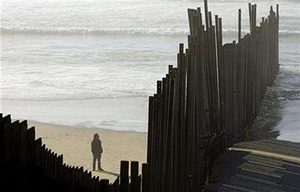 |
 |
 |
 Editorials | At Issue | August 2006 Editorials | At Issue | August 2006  
Indian Nation Divided Over Border Fence
 Jim Gaynor - Reuters Jim Gaynor - Reuters


| | A man in Mexico looks up at the border fence separating the U.S. and Mexico, south of San Diego, in a January 2006 photo. Members of a traditional Indian nation spanning the Arizona-Mexico border are divided over plans to erect a fence to stop drug and human traffickers driving over the desert from Mexico. (Reuters/Fred Greaves) |
Members of a traditional Indian nation spanning the Arizona-Mexico border are divided over plans to erect a fence to stop drug and human traffickers driving over the desert from Mexico.

The U.S. Border Patrol is to start building a 75-mile (120-km) vehicle barrier across the Tohono O'odham nation lands abutting Mexico's Sonora state as early as next month, as part of a move to gain greater control over the porous border

Tribal authorities back the barrier, made of closely set steel posts sunk in concrete. They hope it will stop cars and trucks packed with marijuana and undocumented immigrants streaming into their lands each night from Mexico.

But some traditionalists in the nation, whose name means "People of the Desert," call the barrier an affront to beliefs centered on the natural world, and fear it heralds other get-tough measures that may weaken ties to members in Mexico.

"It's like somebody put a knife in your mother. The barrier will be continually there, and you can't pull it out," said activist Ofelia Rivas, who organizes the "O'odham Voice Against the Wall" pressure group.

The nation of 25,000 members reaches up to Casa Grande in the north, a few miles south of the state capital, Phoenix, and stretches across the international line into Mexico, where some members live in nine scattered communities.

They frequently use informal crossing points -- sometimes little more than gaps in the rusty barbed-wire border fence -- to visit relatives on either side and attend traditional religious ceremonies marking the seasonal calendar.

"Our children and their children are never going to understand what it used to be without a border there," Rivas said in a tiny hamlet of cinderblock and adobe homes on the parched borderline.

"From this point on, it's never, ever going to change."

NO PASSPORTS

Tribal authorities say the barrier is necessary to stop the smugglers, who frequently duel with the Border Patrol in high-speed chases on back roads, and dump tons of trash including clothing and water bottles on the tribe's land.

Chairwoman Vivian Juan-Saunders said plans for building the barrier were drawn up in consultation with the nation's government and would not affect tribal traditions.

"It will not prevent members from crossing the border on foot, and will include three gates to allow them to continue to cross with vehicles," she said in a telephone interview.

The Border Patrol is also adamant that there are no plans to build further barriers that would prevent people crossing on foot through the tribe's harsh, cactus-studded lands, or to require members to obtain passports to do so.

At present tribal identity papers are sufficient to cross the international line informally.

But some traditional Tohono O'odham fear that could change with a drift toward tightening security along the 2,000-mile (3,200-km) border that is gathering pace in Washington.

The U.S. Senate voted in May to build 370 miles of triple-layered fencing against illegal incursions, while the U.S. House of Representatives in December went further, authorizing 700 miles of the barriers.

"Many people have no birth certificates as they were born at home," elder Margaret Garcia, 68, said as she sat just yards from the dusty international line she first rolled over in a horse and cart to attend ceremonies in Mexico as a girl.

"If we are ever required to get passports, it would be very difficult for us." | 
 | |
 |



